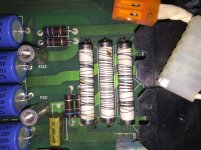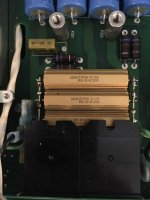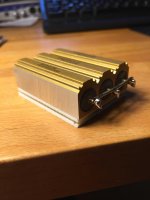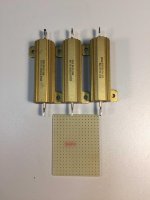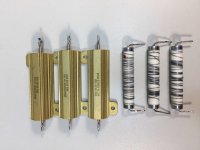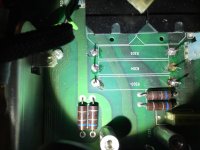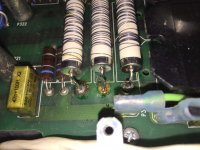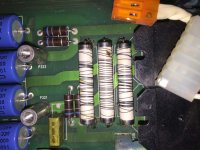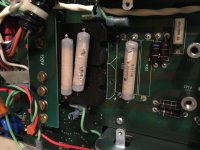RIEDON SP-1976.
RIEDON SP-1976 (10 OHMS-15 W) AND MARK LEVINSON NEW SURGE RESISTORS IS THE ONLY 2 RESISTORS WILL WORK FOR ML-331/332/333/334/335/336/33H. THE REASON THE RESISTORS HAVE TO HAVE JOULES. SPECIAL PROCESS TO GET 290 JOULES AT RIEDON FACTORY CUSTOM MADE.
YOU CAN USE CHEAP $4 SURGE RESISTORS NO JOULES. IT MIGHT WORK FOR A WHILE. WHEN A SHORT OR CAP FAILURE SEVERE DAMAGE WILL TAKE PLACE. I HAVE 4 CUSTOMERS WAITING FOR RIEDON SP-1976 FOR 336 AND 333.
IN FEW WEEKS I WILL HAVE SOME RIEDON SP-1976 FOR SALE.
RIEDON SP-1976 (10 OHMS-15 W) AND MARK LEVINSON NEW SURGE RESISTORS IS THE ONLY 2 RESISTORS WILL WORK FOR ML-331/332/333/334/335/336/33H. THE REASON THE RESISTORS HAVE TO HAVE JOULES. SPECIAL PROCESS TO GET 290 JOULES AT RIEDON FACTORY CUSTOM MADE.
YOU CAN USE CHEAP $4 SURGE RESISTORS NO JOULES. IT MIGHT WORK FOR A WHILE. WHEN A SHORT OR CAP FAILURE SEVERE DAMAGE WILL TAKE PLACE. I HAVE 4 CUSTOMERS WAITING FOR RIEDON SP-1976 FOR 336 AND 333.
IN FEW WEEKS I WILL HAVE SOME RIEDON SP-1976 FOR SALE.
ML engineers - paralleling resistors in soft start ?
brainless
excuse my ignorance, can you please mention your own commercialized design?
I just wanted to add some information to this thread.
6 years ago i purchased a second hand ML No 336. I wanted to check on the condition of the big capacitors and found that the white surge resistors looked a little worn out with uneven windings. They seemed to have been overheated at some point in time, but the amplifier worked fine except for wrong bias setting in both channels.
Now yesterday the amplifier blew the 10A mains fuse in my house. Today I discovered that all three surge resistors were open circuit. So to me it seems like even the recommended ML surge resistors will wear out over time. Nothing else including the big capacitors seem to be faulty and no foul smell og burn marks were observed.
My 336 seems to be updated at one point in time with the white surge resistors, unfortunately with bad workmanship.
6 years ago i purchased a second hand ML No 336. I wanted to check on the condition of the big capacitors and found that the white surge resistors looked a little worn out with uneven windings. They seemed to have been overheated at some point in time, but the amplifier worked fine except for wrong bias setting in both channels.
Now yesterday the amplifier blew the 10A mains fuse in my house. Today I discovered that all three surge resistors were open circuit. So to me it seems like even the recommended ML surge resistors will wear out over time. Nothing else including the big capacitors seem to be faulty and no foul smell og burn marks were observed.
My 336 seems to be updated at one point in time with the white surge resistors, unfortunately with bad workmanship.
Attachments
Maybe I missed it, but I haven’t heard anybody about the relay short circuiting the resistors after switch on.
When switching on, the relay is open and the surge current is effectively restricted through these resistors.
After a short while the relay will be activated to shorten these resistors.
When this relay is malfunctioning, burned contacts or whatever, the three resistors will stay too long or even permanently in line with the transformer, leading to a much higher power consumption that will eventually burn them.
The other way around, when the relay contacts are welded together, you will blow your fuses everytime at switch on.
Hans
When switching on, the relay is open and the surge current is effectively restricted through these resistors.
After a short while the relay will be activated to shorten these resistors.
When this relay is malfunctioning, burned contacts or whatever, the three resistors will stay too long or even permanently in line with the transformer, leading to a much higher power consumption that will eventually burn them.
The other way around, when the relay contacts are welded together, you will blow your fuses everytime at switch on.
Hans
So, I just wanted to conclude on my findings and repair of my Mark Levinson No 336.
Please note this is how I have chosen to repair the inrush circuit and that you may have other ideas that also will do the job nicely as well. Also note that this circuit is connected directly to the mains where you have to consider repair of live parts with correct insulation and creepage/clearance distances. Don’t try this at home if you are not skilled in these matters!
Hans Polack
I also feared that the contacts of the shorting relay may have suffered burn or damage when the amplifier was turned on with blown surge resistors. This could for sure lead to sticky contacts, in which case the house mains fuse would continue to blow even after repair of the surge resistors. In my case the relay seems to work fine after the surge resistor repair, but I don’t know whether the relay contacts have suffered some damage. Time will tell.
Repair of the ML 336 surge resistor circuit
I purchased the amplifier 6 years ago from the UK and found during my capacitor inspection that the white surge resistors looked weird with uneven windings but the amplifier worked fine. Now to day with the burned surge resistors it is clear that the resistors are overloaded every time the amplifier is switched on and that they will wear out over time. Therefore, I didn’t want to order the special RIEDON surge resistors but opted to find a more long-lasting solution instead.
So, what are the requirement specification for these three surge resistors? I initially did a PSpice simulation of the total mains inrush circuit, DC blocking circuit, mains transformer, rectifiers and the large capacitor bank. The result was that each surge resistor should be able to withstand an energy pulse of at least 255 Joules. Comparing this specification to that stated in the RIEDON SP-1976 document, kindly presented in this thread by renjy651, it can be seen that they have an energy pulse rating of 290 Jules. Close, but with a small margin it seems OK at first glance.
The big capacitors have a tolerance range of +/-20% and if they are on the high side each surge resistor will see a total energy of 306 Joules. This means that the RIEDON resistors can be working right at or a little above their pulse rating. This could be the reason why they seem to slowly wear out over 6 to 8 years - in my amplifier anyway.
To make a long story shorter, I purchased some Vishay Dale resistors: 10 Ohm, 1%, 50W, 5 x power in 5 sec. This resistor should be able to withstand a short energy pulse of 1250 Joules. They do not have an energy pulse rating but there should be plenty of margin. Another good thing is that the resistive element is mounted in an aluminum housing, which will prevent pieces of wire flying everywhere as I experienced with the blown RIEDON resistors.
The problem with these Vishay Dale resistors is that they are too big to fit in the same place as the RIEDON resistors.
See image below.
At the same time, I had to fix the previous bad repair work as good as I could. The repair work was probably done in the UK when the large capacitors were updated.
See images below.
The Vishay Dale resistors have to fit on this small PCB.
See images below.
There is no need for heatsinking due to the very short energy surge, so I grinded the aluminum housing down to fit the PCB. The resistors were glued to the small PCB using 3M 4016 double coated soft tape. This tape can withstand working temperatures of 220⁰F / 104⁰C. The same tape was used to glue the surge resistor assembly onto the large ML PCB. Also, the soldering pins of the resistors were cut down a little bit in order to fit into the narrow space. The temperature rise on the remaining heatsink can be calculated to less than +20⁰C after an amplifier switch on.
See image below.
Mounting and soldering work is difficult due to the very limited space. Remove the spade connector just to the right of the new surge resistor bank.
See images below.
After this repair my ML 336 amplifier works fine and measurements show that the large capacitors charge nicely at the rate, they are supposed to during power up.
This is what I have chosen to do. You may have other and better ideas.
Please note this is how I have chosen to repair the inrush circuit and that you may have other ideas that also will do the job nicely as well. Also note that this circuit is connected directly to the mains where you have to consider repair of live parts with correct insulation and creepage/clearance distances. Don’t try this at home if you are not skilled in these matters!
Hans Polack
I also feared that the contacts of the shorting relay may have suffered burn or damage when the amplifier was turned on with blown surge resistors. This could for sure lead to sticky contacts, in which case the house mains fuse would continue to blow even after repair of the surge resistors. In my case the relay seems to work fine after the surge resistor repair, but I don’t know whether the relay contacts have suffered some damage. Time will tell.
Repair of the ML 336 surge resistor circuit
I purchased the amplifier 6 years ago from the UK and found during my capacitor inspection that the white surge resistors looked weird with uneven windings but the amplifier worked fine. Now to day with the burned surge resistors it is clear that the resistors are overloaded every time the amplifier is switched on and that they will wear out over time. Therefore, I didn’t want to order the special RIEDON surge resistors but opted to find a more long-lasting solution instead.
So, what are the requirement specification for these three surge resistors? I initially did a PSpice simulation of the total mains inrush circuit, DC blocking circuit, mains transformer, rectifiers and the large capacitor bank. The result was that each surge resistor should be able to withstand an energy pulse of at least 255 Joules. Comparing this specification to that stated in the RIEDON SP-1976 document, kindly presented in this thread by renjy651, it can be seen that they have an energy pulse rating of 290 Jules. Close, but with a small margin it seems OK at first glance.
The big capacitors have a tolerance range of +/-20% and if they are on the high side each surge resistor will see a total energy of 306 Joules. This means that the RIEDON resistors can be working right at or a little above their pulse rating. This could be the reason why they seem to slowly wear out over 6 to 8 years - in my amplifier anyway.
To make a long story shorter, I purchased some Vishay Dale resistors: 10 Ohm, 1%, 50W, 5 x power in 5 sec. This resistor should be able to withstand a short energy pulse of 1250 Joules. They do not have an energy pulse rating but there should be plenty of margin. Another good thing is that the resistive element is mounted in an aluminum housing, which will prevent pieces of wire flying everywhere as I experienced with the blown RIEDON resistors.
The problem with these Vishay Dale resistors is that they are too big to fit in the same place as the RIEDON resistors.
See image below.
At the same time, I had to fix the previous bad repair work as good as I could. The repair work was probably done in the UK when the large capacitors were updated.
See images below.
The Vishay Dale resistors have to fit on this small PCB.
See images below.
There is no need for heatsinking due to the very short energy surge, so I grinded the aluminum housing down to fit the PCB. The resistors were glued to the small PCB using 3M 4016 double coated soft tape. This tape can withstand working temperatures of 220⁰F / 104⁰C. The same tape was used to glue the surge resistor assembly onto the large ML PCB. Also, the soldering pins of the resistors were cut down a little bit in order to fit into the narrow space. The temperature rise on the remaining heatsink can be calculated to less than +20⁰C after an amplifier switch on.
See image below.
Mounting and soldering work is difficult due to the very limited space. Remove the spade connector just to the right of the new surge resistor bank.
See images below.
After this repair my ML 336 amplifier works fine and measurements show that the large capacitors charge nicely at the rate, they are supposed to during power up.
This is what I have chosen to do. You may have other and better ideas.
Hello,
Surely your new resistors can survive a short but big current burst but only if it is short!
A few decades ago i used a similar resistor to create a kind of soft start to the famous Hiraga 30 watt which uses big caps. Normally the French 30 watt kit had a 300VA? double C core but i used a 500VA EI core because C core was out of stock.
Anyhow i managed to make a fire cracker from such an aluminium cased resistor. The resistive element has only two ways to go left or right and it did.
Probably if the dcr is low enough, the charging current will be BIG but short maybe if it is to high the current will be lower but it will be there for a longer time.
Greetings, Eduard
Surely your new resistors can survive a short but big current burst but only if it is short!
A few decades ago i used a similar resistor to create a kind of soft start to the famous Hiraga 30 watt which uses big caps. Normally the French 30 watt kit had a 300VA? double C core but i used a 500VA EI core because C core was out of stock.
Anyhow i managed to make a fire cracker from such an aluminium cased resistor. The resistive element has only two ways to go left or right and it did.
Probably if the dcr is low enough, the charging current will be BIG but short maybe if it is to high the current will be lower but it will be there for a longer time.
Greetings, Eduard
Eduard, I fully understand you concern, nobody wants a firecracker inside their powerful and expensive amplifier.
I have looked for a Vishay Dale failure mode specification on their wire wound resistors but couldn’t find any.
The aluminum housing is filled with some sort of electrical insulation but heat conducting material and Vishay Dale claim some ceramic, steatite or aluminum oxide to be used. The problem is that if there is any moisture left, we could imagine a firecracker situation.
For this worst-case scenario to happen two faults must be present at the same time. The fault in the amplifier must be of such nature that the mains current draw is below the mains fuse rating in your house (10A) with the surge resistors still in circuit, and the shorting relay must be faulty at the same time preventing the relay to short the surge resistors. In this case heat will rapidly build up and we could face a firecracker situation or just a peaceful small pop.
On the other hand, the specified RIEDON resistors will throw several small pieces of half windings around inside the cabinet when they blow. This is what I found.
So what is best: Do you want to roast or do you want to fry?
I guess I will have to trust Vishay Dale.
I have looked for a Vishay Dale failure mode specification on their wire wound resistors but couldn’t find any.
The aluminum housing is filled with some sort of electrical insulation but heat conducting material and Vishay Dale claim some ceramic, steatite or aluminum oxide to be used. The problem is that if there is any moisture left, we could imagine a firecracker situation.
For this worst-case scenario to happen two faults must be present at the same time. The fault in the amplifier must be of such nature that the mains current draw is below the mains fuse rating in your house (10A) with the surge resistors still in circuit, and the shorting relay must be faulty at the same time preventing the relay to short the surge resistors. In this case heat will rapidly build up and we could face a firecracker situation or just a peaceful small pop.
On the other hand, the specified RIEDON resistors will throw several small pieces of half windings around inside the cabinet when they blow. This is what I found.
So what is best: Do you want to roast or do you want to fry?
I guess I will have to trust Vishay Dale.
Tubeoman you safe some money for some donuts
Mark Levinson 331/332/333/334/335/336/33h Surge Widerstande | eBay
Mark Levinson 331/332/333/334/335/336/33h Surge Widerstande | eBay
Tubeoman you safe some money for some donuts
Mark Levinson 331/332/333/334/335/336/33h Surge Widerstande | eBay
What a fraud.
Farnell sells them for €2.88 each.
Hans
Attachments
Tubeoman
You did not use RIEDON SP-1976. the Picures are cheap $4 surge resistors it will never work. The ML-336 need a update according to USA service center replace all 8 power supply caps. replace 2 OPAMP with LT1097CN8. replace 0.01uF 200V with ceramic axial caps. Replace 68uF 35v with 68uF 60V New Sprague. Replace 150uF/150v 4 caps with 150uF 200v . And last replace the surge resistors with ML wire wound resistors service center have none in stock. Only Riedon will work with 290 joules.
Hans Polak It cost $22 for each for Riedon Sp-1976 to make at Riedon factory in California USA.
You did not use RIEDON SP-1976. the Picures are cheap $4 surge resistors it will never work. The ML-336 need a update according to USA service center replace all 8 power supply caps. replace 2 OPAMP with LT1097CN8. replace 0.01uF 200V with ceramic axial caps. Replace 68uF 35v with 68uF 60V New Sprague. Replace 150uF/150v 4 caps with 150uF 200v . And last replace the surge resistors with ML wire wound resistors service center have none in stock. Only Riedon will work with 290 joules.
Hans Polak It cost $22 for each for Riedon Sp-1976 to make at Riedon factory in California USA.
THIS MARK LEVINSON 336 HAD THE ORIGINAL ML WHITE WIRE WOUND REISTORS THAT WAS MELTED. HE REPLACED IT WITH RIDEON SP-1976 WITH OUT THE UPDATE. THE RESISTORS STILL SURVIVED WIRES DID NOT BREAK. STILL READING 10 OHMS BUT SILICONE COATING OPENED THE REASON SEVERE HEAT. HE IS TRYING TO REPLACE ALL THE BAD PARTS.
Attachments
I played with constantan wire when I was in primary school...
Resistance Calculator -- EndMemo
Resistance Calculator -- EndMemo
THIS MARK LEVINSON 336 HAD THE ORIGINAL ML WHITE WIRE WOUND REISTORS THAT WAS MELTED. HE REPLACED IT WITH RIDEON SP-1976 WITH OUT THE UPDATE. THE RESISTORS STILL SURVIVED WIRES DID NOT BREAK. STILL READING 10 OHMS BUT SILICONE COATING OPENED THE REASON SEVERE HEAT. HE IS TRYING TO REPLACE ALL THE BAD PARTS.
When almost unobtainable expensive components break down, it mostly points in the direction of a design error.
The route that tubeoman took is far superior.
Hans
Renjy651
Thanks for listing all the updates for the ML No 336 which I assume comes from Mark Levinson. My amplifier has already been updated according to this list, so I am happy with that.
The only thing is the RIEDON SP-1976 surge resistors which according to my calculations are working just at their rating of 290 Joules. It seems like they after 5 to 8 years will wear out and finally burn throwing half pieces of windings all over the place. This is the reason why I chose the Vishay Dale power resistors which are specified at 1250 Joules.
I perfectly understand the highly skilled Mark Levinson development team because they had to come up with a solution which could easily be mounted by service technicians all over the world. My solution is not easy to implement but my take is that they will last much more than 8 years.
Tubeoman
Thanks for listing all the updates for the ML No 336 which I assume comes from Mark Levinson. My amplifier has already been updated according to this list, so I am happy with that.
The only thing is the RIEDON SP-1976 surge resistors which according to my calculations are working just at their rating of 290 Joules. It seems like they after 5 to 8 years will wear out and finally burn throwing half pieces of windings all over the place. This is the reason why I chose the Vishay Dale power resistors which are specified at 1250 Joules.
I perfectly understand the highly skilled Mark Levinson development team because they had to come up with a solution which could easily be mounted by service technicians all over the world. My solution is not easy to implement but my take is that they will last much more than 8 years.
Tubeoman
- Status
- This old topic is closed. If you want to reopen this topic, contact a moderator using the "Report Post" button.
- Home
- Amplifiers
- Solid State
- Mark Levinson 336 blowing fuses in home
